Look, learn and cherish
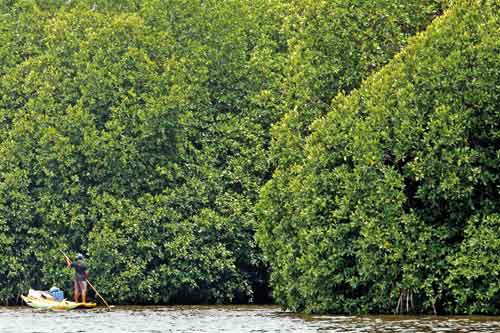
A stone’s throw from the museum: The Pambala lagoon with 17 of the 22 species of mangroves found in Sri Lanka. Pix by M.A. Pushpa Kumara
Ensconced within a cool and comforting one-hectare haven is a tiny but vibrant showpiece, just 100m off the Negombo-Chilaw Road beyond the 66th km-post at Pambala.
It is the first-ever Mangrove Museum in the world and a walk through it opens up the wonders of this crucial ecosystem.
A pair of tiny sea-horses keep our attention riveted as also all the other exhibits including prawns and crabs in different colours, shapes and sizes, the shells of pearl-producing oysters in all their mollusc variety, fishes, crustaceans, reptiles and butterflies, while from an observation point through huge glass-panes we see mangroves in the wild.
The Mangrove Museum, opened on July 26, last year, on World Mangrove Day by President Maithripala Sirisena, is the jewel in the crown of a major initiative named the ‘Seacology-Sudeesa Sri Lanka Mangrove Conservation Programme’.
“Meya loke inna paranama sarapayek,” says the programme’s Manager of Conservation and Plant Nursery, Douglas Tissera, pointing to the mada panuwa (Acrochordus granulatus or diya maha-goda-maha) as one of the five most ancient species of snakes. This is as the huge vaalakkadiya (Hydrophis schistosa or beaked sea snake), the most dangerous sea snake has also found a place here.
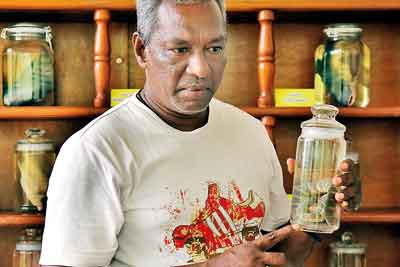
Conservation Manager Douglas Tissera: Explaining an exhibit
“There are no special exhibits as all are special,” says Douglas explaining that the kadol kakuluwa (Scylla serrata or giant mud-crab), a delicacy, sells at the exorbitant rate of Rs. 3,000 per kilo!
Off the shelf comes the bottle showing the heliwalang kossa (Epinephelus lanceolatus or giant grouper) which lives in the dark deep waters of a lagoon, the numbers of which would reduce dramatically if the “kalapuwa goda vunoth” (fills up).
We are following more than 10,000 visitors including over 7,000 schoolchildren who have stopped at each and every exhibit with oohs and aahs, taking in the beauty of the mangrove-ecosystem in all its glory.
The aim of the museum is to provide mangrove conservation knowledge, so that wherever the visitors go back to, across the world or to the far corners of Sri Lanka, they will not only cherish these unforgettable memories but also do whatever possible to protect and safeguard mangroves.
A short walk along a sandy trail dominated by crab-holes leads to a small jetty from where we step into a boat and with Douglas using a bamboo in punt-style go out onto the Pambala lagoon, leaving the cares and stresses of city life behind, with not a sound of the rat-race but the calls of birds and glimpses of pristine white kokas.
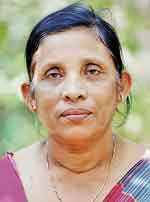
Annette Primrose Fernando
A lone fisherman is out in his canoe in the noonday heat, like us ‘punting around’ and casting his veesi-dela (throw-net) to earn his livelihood, with Douglas explaining that these “small” fishermen are reluctant to use motor-boats which need kerosene oil as the lagoon gets polluted. Others use the technique of “mas-athu danawa” (to cut and throw into the lagoon a few mangrove branches) which attract small fish which can then be caught easily.
The Pambala lagoon is fed by two moya (estuaries), the Deduru Oya which comes from Chilaw and the Lunu Oya from Thoduwawa and Douglas adds that the Dutch Canal, utilized to transport salt between Palaviya close to Puttalam and the Colombo Port flowed through this lagoon.
Before touring the museum, we are transported into the world of mangroves, through a documentary with the haunting notes of a song written by Sunil Sarath Perera and sung by Amarasiri Pieris filling the auditorium and setting the right tone.
With mangroves which have adapted to living in brackish water and form a protective ring around this island being essential, earlier we get an ‘overview’ of the ‘Sri Lanka Mangrove Conservation Programme’.
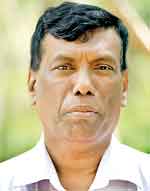
W.P. Jayathilaka Perera
Starting back in 1992, the Small Fisheries Federation (Sudeesa) which is currently headed by Chairman Dr. Anuradha Wickramasinghe, is the umbrella organisation which mobilised 1,500 community-based organisations (CBOs) with a membership of 15,000 along the coastal belt.
The beginnings are dwelt on by the Project Manager of the Sudeesa-Seacology Sri Lanka Mangrove Conservation Programme, W.P. Jayathilaka Perera; the Accountant of the Small Fisheries Federation of Sri Lanka, P.A.S. Marlon; the Regional Manager of the north-western area programme, Annette Primrose Fernando; and Mr. Tissera.
The CBOs dot all the coastal regions and look after the interests of the small fishermen who are dependent on theppam and oru in the kalapu (lagoons) to eke out a living as well as those who are earning daily wages as labourers on bigger boats and multi-day trawlers. The programme also makes these small fishermen and their families understand the importance of safeguarding lagoons including mangroves.
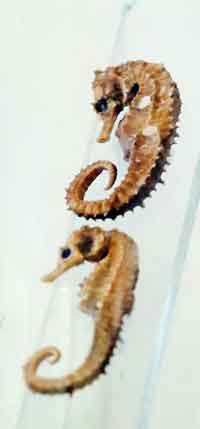
The tiny but lovely Sea horses
Later came the Sudeesa Social Enterprise Development Company, a shareholding company, of which such fishing folk became members and would in the future invest their earnings. This was after they had been trained in value-addition to fish as well as how to embark on self-employment projects.
The federation is a charity, while the company is the business arm.
“The main objective was to set off a trend where the mangroves would be protected by those living close to the lagoon,” says Jayathilaka, while Douglas explains that they also began three mangrove nurseries in Pambala in Chilaw, Saranagama in Mundel and Nachchikalliya in Kalpitiya to grow more than 500,000 mangrove plants.
All those plants have now been distributed and are thriving along the coastal belt where there has been degradation of mangroves and the Pambala ‘model nursery’ with all 22 species of mangrove plants found in Sri Lanka acts as a demonstration site. Incidentally, the Pambala lagoon has 17 of these 22 species.
By May 2015, the federation linked up with the Seacology Institute, an island-conservation organization based in the United States of America working in 58 countries and the Mahaweli Development and Environment Ministry to launch a five-year programme to protect the mangroves in 14 coastal districts in the country. The other stakeholders are the Fisheries and Aquatic Resources Development Ministry and the Education Ministry.
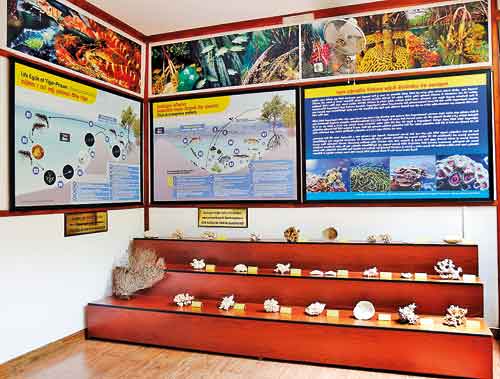
The museum: Educating people on mangrove functions
While some areas of Sri Lanka experienced protection through mangroves during the devastating tsunami which engulfed it in December 2004 mangroves are important coastal ecosystems which provide ecological and economic services. Mangroves also act as a ‘sink’ for carbon with a large potential for carbon sequestration.
Costing $3.4 million (over Rs. 500 million), the programme will protect Sri Lanka’s existing 15,000 hectares of mangrove forests, while restoring nearly 4,000 hectares. It is also being carried out scientifically, with the Scientists’ Forum comprising all botanists attached to the universities monitoring it and guidance also being provided by Japan’s Okinawa University.
Already, the programme is working with fervour towards its vision of sharing traditional and contemporary knowledge of the mangrove ecosystem throughout the world, in a major effort to become the ‘saviour’ of mangroves which are essential for the survival of humankind.


